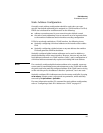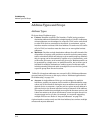
3-12
IPv6 Addressing
Address Types and Scope
In binary notation, the fixed prefix for link-local prefixes is:
1111 1110 10 = fe80/10
For more on link-local addresses, refer to “Link-Local Unicast Address” on
page 3-13.
Routable Global Unicast Prefix. This well-known 3-bit fixed-prefix indi-
cates a routable address used to identify a device on a VLAN interface that is
accessible by routing from multiple networks. The complete prefix is 64 bits,
followed by a 64-bit interface identifier. For example, the leading 2 in the first
octet of the following address illustrates a global unicast address:
2001:db8:260:212:215:60ff:fe7a:adc0/64
In binary notation, the fixed prefix in this example appears as follows:
0010 0000 = 20/3
Unique Local Unicast Prefix (fd). This well-known fixed prefix is defined
as FC00/7. However, the eighth high-order bit must also be set to 1, resulting
in a fixed prefix of fd00/8. (In the future, setting the eighth high-order bit to
zero may become an option.) This prefix signifies a routable address intended
for use within the boundaries of a site or organization. For example, the
leading fd in the first octet of this address illustrates a unique local unicast
address intended to be used in a privately defined network.
fd00:00ff:0C00:000a:215:60ff:fe7a:adc0
Unique local unicast addresses are described in more detail under "Unique
Local Unicast IPv6 Address" on page 3-19.
Multicast Prefix (ff). This well-known 8-bit fixed prefix signifies a perma-
nent or temporary multicast address. The second 8 high-order bits are used
for flags and scope for the multicast address. The remaining 112 bits define
the multicast group identifier. For example:
ff02::1:ffc7:b5b9
For more information, refer to “Multicast Application to IPv6 Addressing” on
page 3-21.


















